With some bad driving, bad luck, and bad opponents blotting my experiences with it, the HPD ARX-01c prototype on iRacing has always left something of a bad taste in my mouth.
The first time I drove it after the car was released seven years ago, it immediately put me outside of my comfort zone. The downforce, the speeds, and the quick thinking required to cut through slower traffic were all foreign to me as a burgeoning GT driver.
Since then, I’ve raced the car only twice, both times in the old ISRA League’s Grand Touring Championship series in the fall of 2013. In my first race at Watkins Glen, I lost a solid top-five run when I bumped one of my now-teammates in a GT car entering turn 1 and took some slight aero damage, which hindered me for the rest of the race and dropped me to sixth at the finish.
In my other appearance in the HPD at Long Beach, I was en route to a likely podium when one of my then-teammates crashed just ahead of me, and on the narrow street circuit, I had nowhere to go but right into the side of his car.
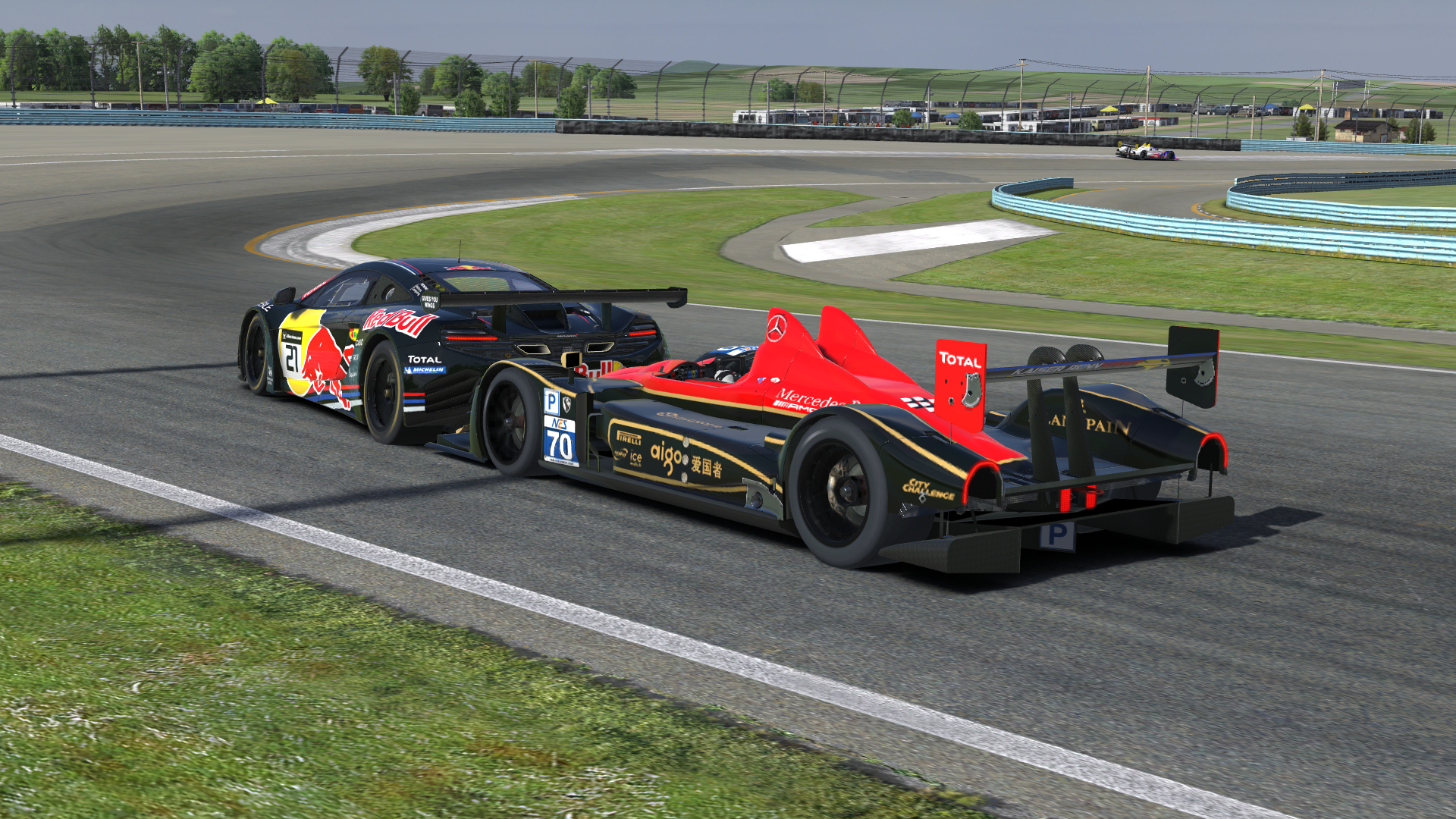
Rear-ending a McLaren entering turn 1 at Watkins Glen.
Aside from that, my experience with the HPD all comes from the cockpit of a GT car and having them drive around me — or in some cases, into me. In my first ever Prototype/GT Challenge race, an aggressive HPD driver crashed me in the middle of a corner and blamed me for, apparently, not disappearing from the track when he was coming through.
In another case just 10 minutes into a six-hour NEO Endurance Series race at Monza, an HPD side-swiped my teammate Karl in our Ford GT. That may be a second-hand experience, but like with smoke, that doesn’t mean it was any less harmful.
To be fair, not all HPD drivers are so impatient or reckless, and not all multi-class races alongside the HPD are so eventful or memorable. But those traumatic experiences plus countless divebombs and ill-advised passes along the way left me convinced that there’s a reason the car is sometimes referred to as the Honda Punting Device.
After years of being the top dog among iRacing’s prototypes, the HPD has now been dethroned by the LMP1-class Audi R18 and Porsche 919. The new NEO Endurance Series season is set to feature those cars as well as iRacing’s trio of GTE cars, and since I will be both driving in the series and covering it as the web correspondent for the NEO website, I thought I should spend some time on my Summer Road Trip in the official iRacing Le Mans Series to check out the dynamic between the three classes and see how the HPD and its drivers are handling middle child syndrome.
The best way to do that, I figured, was to become what I’ve often despised: an HPD driver.
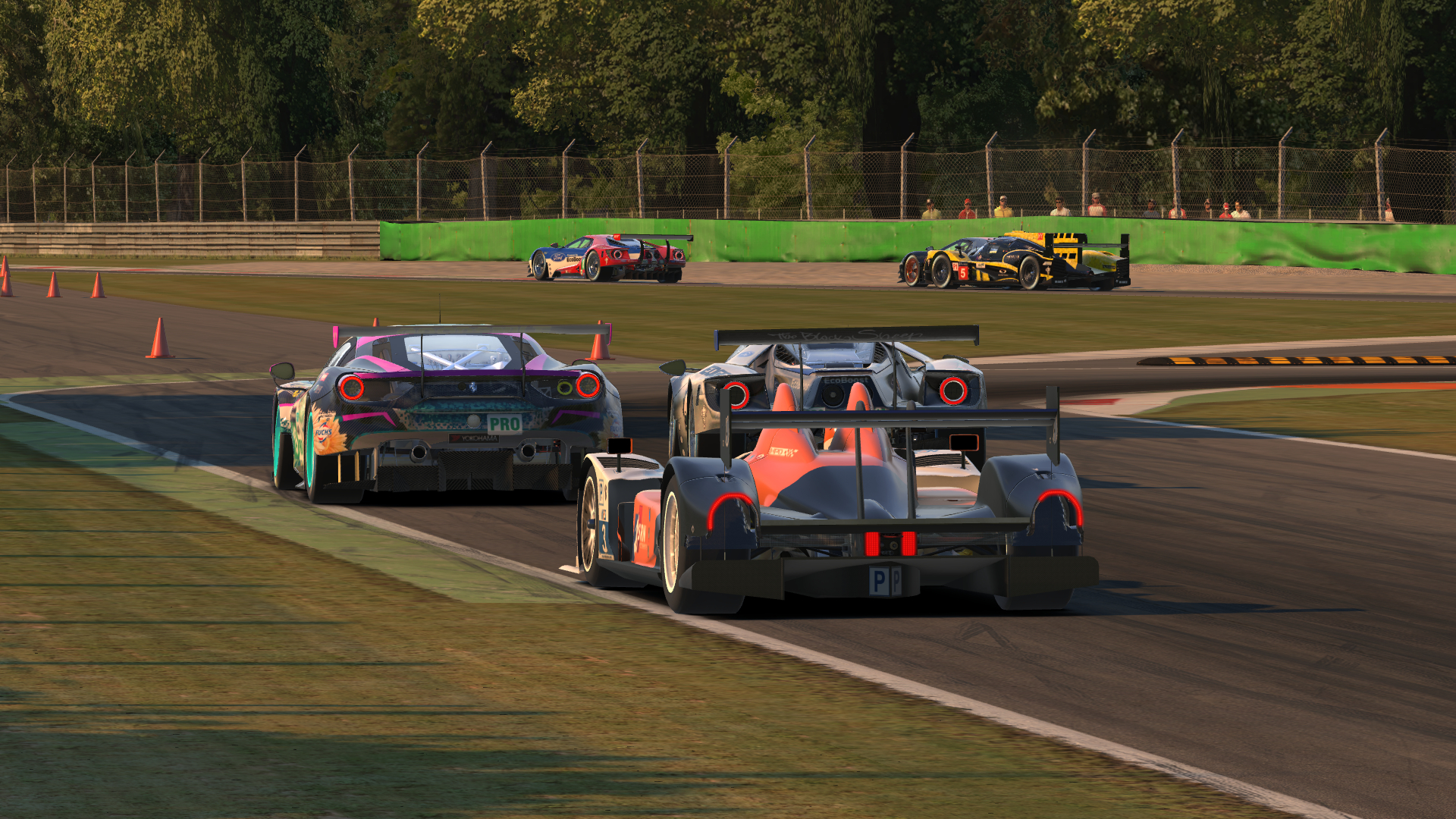
Stuck behind battling GT cars entering turn 1.
A World Away
My first time in a prototype after six straight weeks — and many months prior — racing exclusively GT cars was a major change of pace, quite literally.
In recent weeks, I’ve driven cars such as the Audi 90 GTO and V8 Supercar, which have tons of power connected to the road by what sometimes feels like little more than a rubber band. The HPD, on the other hand, seems like it has unlimited downforce and never particularly felt out of control, even running a low-downforce setup around Monza this week.
Any time the car started to get a bit sideways, such as through the snaking Ascari chicane, the aerodynamic assistance provided by the car’s wing, diffuser, dive planes, and other bits kicked in and kept it going straight. But that doesn’t mean it’s effortless to drive.
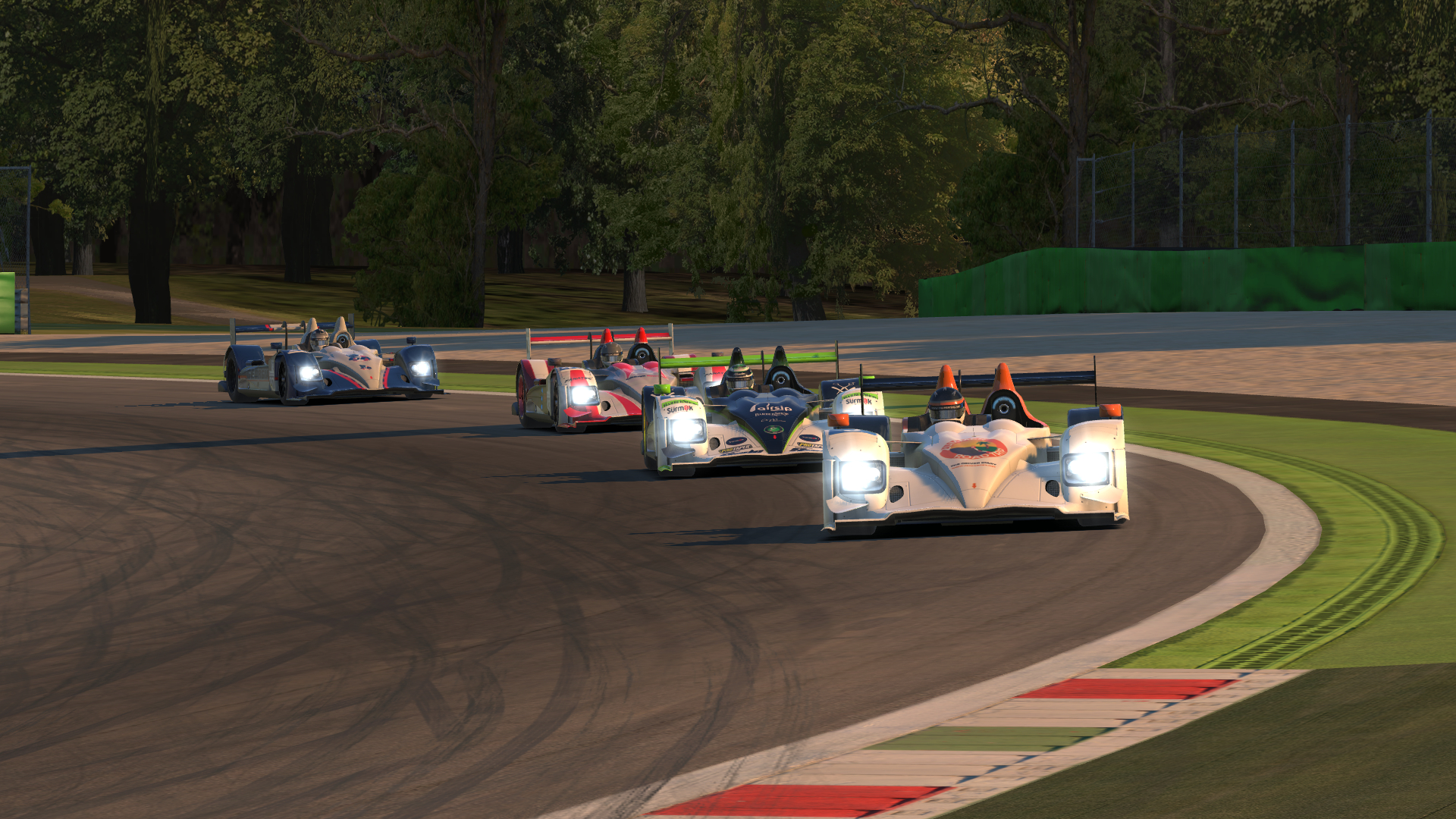
Leading a line of HPDs to the green flag.
In my first practice laps, three major characteristics of the HPD and its position in the iRacing Le Mans Series caught my attention. First, there was the aero push when following another car. While this is sometimes an issue in GT cars, I’ve rarely felt it as severely as I did in the HPD. After struggling to get around much slower prototypes in practice, I feared that passing or even keeping up with other HPDs during a race would be nearly impossible.
Next, when I clipped a kerb a bit too much, the car also began to push and was at least a tenth of a second slower down each straightaway. When I pitted, I expected to see some considerable damage repair time. To my surprise, it was only 2.5 seconds. That was a sobering reminder of just how sensitive the HPD is to damage, and how I’d need to avoid hitting any kerbs or cars during the hour-long races this week.
Finally, as I encountered some traffic, I discovered that I had to keep my head on a swivel to watch for GT cars out the windshield and the fast-accelerating LMP1s in my mirror. As a GT driver, I’m used to watching everything approach me from behind. In a way, the HPD’s position of both passing and being passed seemed more difficult.
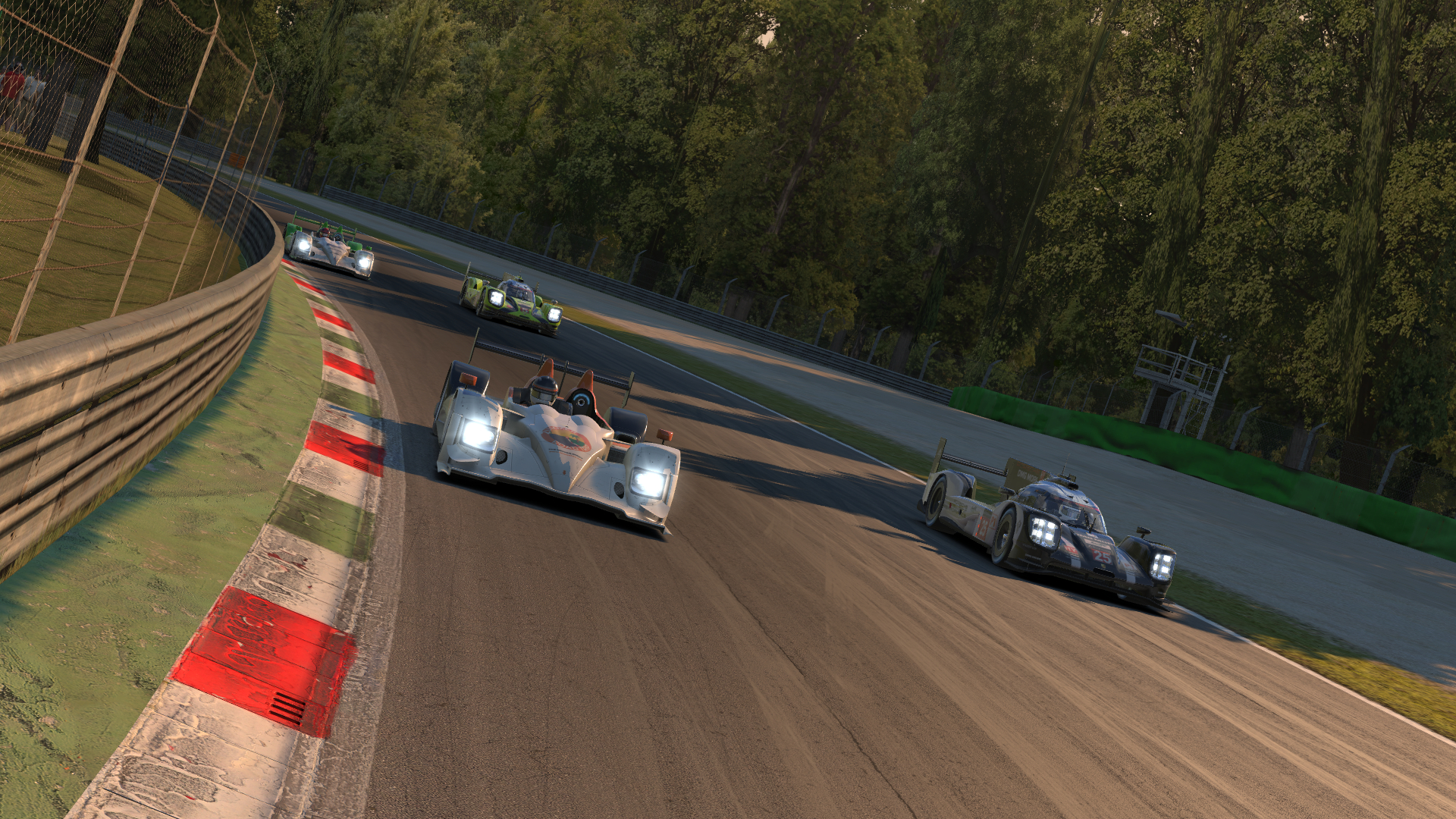
HPDs side-by-side with LMP1s through Curva Grande.
Getting used to traffic reminded me of another frustration with HPD drivers. From my GT experience, the sort of prototype driver I hate most isn’t the one who divebombs every corner or is multiple seconds off the pace.
The worst type of prototype driver is The Indecisive Prototype Driver — the one who peeks to your inside approaching a braking zone but doesn’t attempt a pass, or the one who moves to your outside on corner exit but backs off, compromising the speed and line of both cars.
As I became more accustomed to passing GT cars in practice, I was careful to avoid being indecisive and always make my intentions clear — if I planned to make a pass, I’d flash my headlights and position my car clearly to the inside entering the braking zone; otherwise, I’d sit behind them and back off early to help set up a pass on corner exit.
After a few dozen laps of practice, I was ready to register for a race. I was sure that I didn’t yet know everything about racing the HPD, but as in real life, some things can’t be taught in practice and are best learned on the job.
Thick and Fast
For my first race of the week on Wednesday evening, just four HPDs were in the field. In a way, this wasn’t a bad thing for me since I’d get to spend more time focusing on traffic, and there would be a lot of it with 31 GT cars in the field.
I qualified on the pole by a full second so it seemed I had the speed to win, but my execution was tested early in the race. On lap 2, I cut a bit too much of the inside kerbing entering the Variante della Roggia chicane and received a slowdown penalty that cost me the lead.
Thankfully, it hadn’t damaged my car and I was relieved to find that I had the pace to get back out front. But to do it, I’d have to contend with the same factors as in practice: aero push, a higher risk for damage while following another car, and eventually, traffic coming from both directions.
Fortunately for me, before we ever made it to the slowest GT cars, the leader drove in too deep entering Ascari and ran through the gravel, which handed the lead back to me and allowed me to pull away.
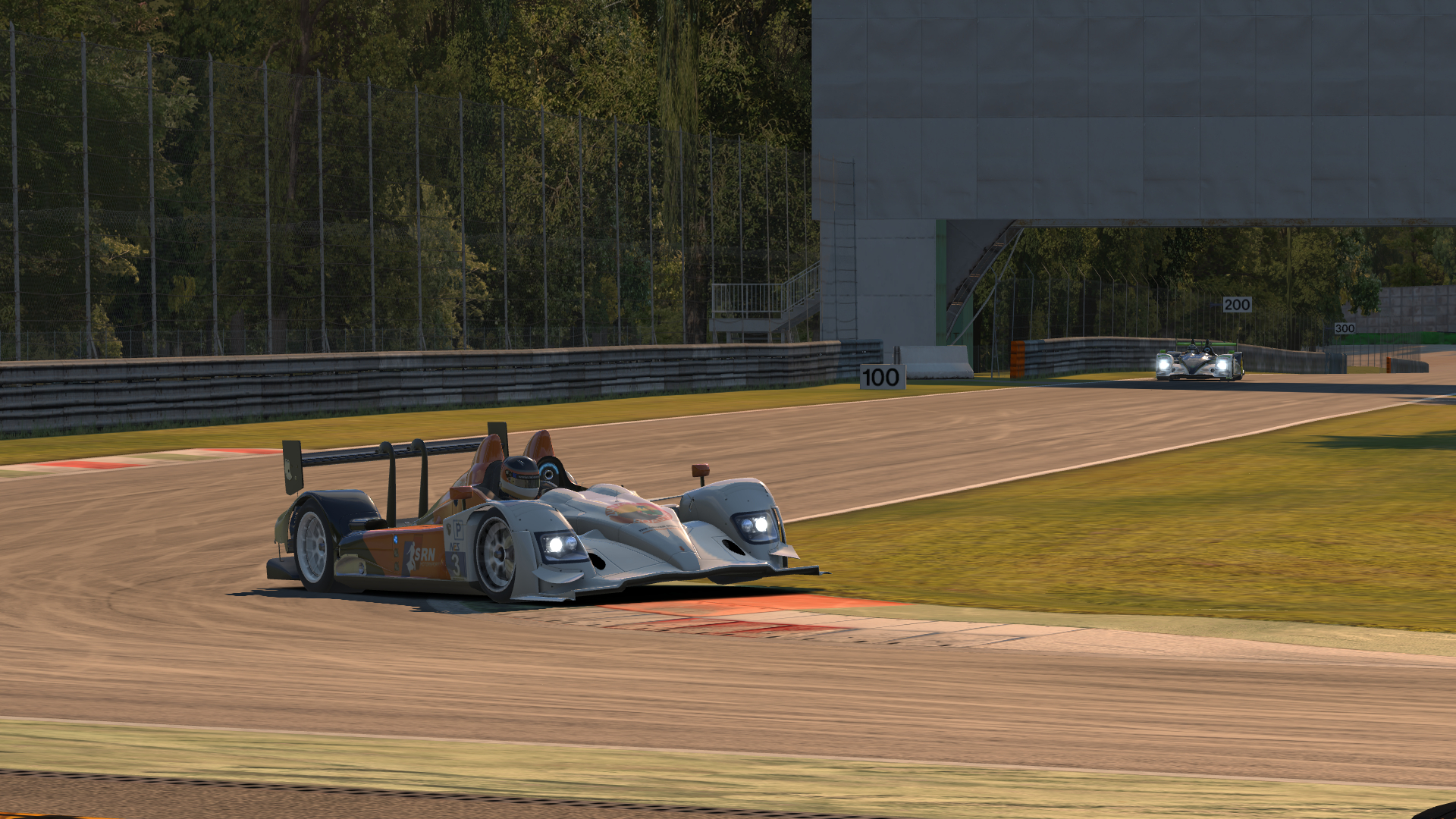
Taking too much kerb in the Variante della Roggia chicane.
In the first round of lapping, the traffic was thick. Sometimes, GT cars were two-wide in front of me so I simply had to back off, brake early, and wait to pass them after another corner or two. The sheer volume was almost overwhelming, and it didn’t seem like it would ever end. After three straight laps of passing cars, I realized I was only halfway through the GT field.
When the LMP1 cars arrived a few laps later, our interactions were much more straightforward, both because of their smaller field and because they completed most of their passes under acceleration using their hybrid boost.
That doesn’t mean there weren’t any issues between classes, though. I heard names like idiot and a**hole thrown out over the driver chat, and after the race, I watched the replay to see several instances of contact between LMP1 and GTE cars.
Before hitting the track this week, I consulted with my teammate and longtime HPD driver Dean Moll, and he warned me that there are some aggressive LMP1 drivers in this series, but they usually knock themselves out during the first round of GT traffic. Sure enough, after just 15 laps of this race, only six of the starting ten LMP1s were left on track.
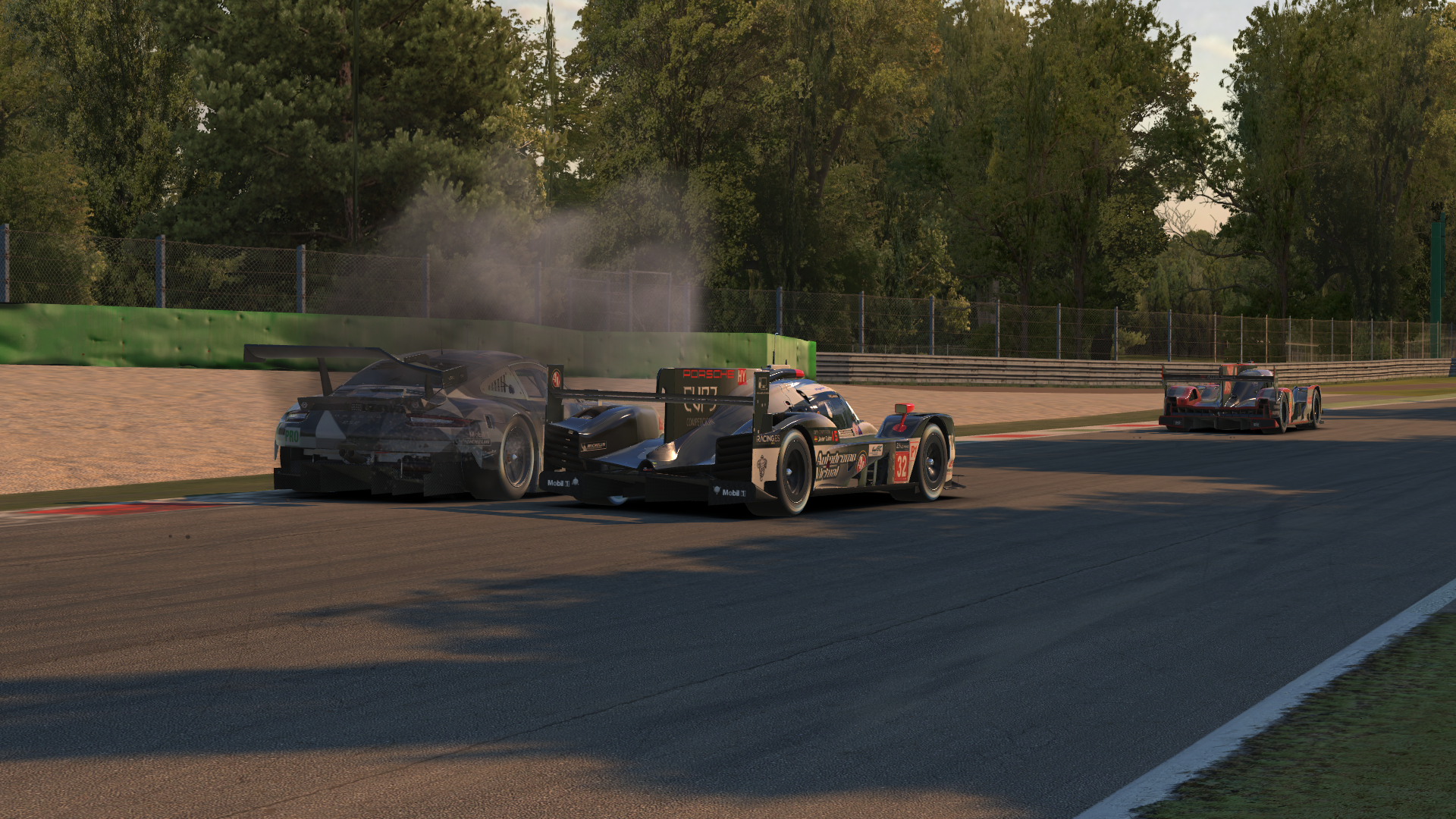
Contact between an LMP1 and a GTE Porsche early in the race.
Even despite losing some time behind battling GT drivers, after the first trip through traffic, I had doubled my lead from 8 to 16 seconds. Before encountering the massive GT field for the second time, I pitted to take enough fuel to finish, although it didn’t make too much of a difference when I stopped since cars had spread out over almost the entire track by that point in the race.
With a big lead, I could at least take fewer risks when passing cars. If I wouldn’t be completely alongside them entering a braking zone, I would generally back off early and ride behind them. That sort of body language is a valuable tool in multi-class racing, but while I wasn’t at risk of being The Indecisive Prototype Driver, I worried that I might seem like his oddball cousin, The Creeper. As a GT driver, having a prototype fill your mirrors entering a corner instead of making a seemingly straightforward pass can be a bit unsettling.
Once while lapping a pair of battling GTEs, we were coming up on an HPD missing its rear wing. I didn’t know how that damaged car might behave, so I just rode behind one of the GTs from Ascari all the way through Parabolica. On corner exit, he seemed frustrated that I had waited so long to pass him, but I assured him that I was just being cautious — one case where spoken language is much more clear than body language.
After an hour of almost constant traffic, I finished my first official race in the HPD with only one incident and a win by more than 30 seconds. Overall, I found it was a mix between fun and frustration. It was interesting to see traffic from a different vantage point, but with so much of it, I found it difficult to get in a rhythm, which is usually when I’m most comfortable.
iRacing Le Mans Series - Race 1
Wednesday, July 25 at 7:00 pm EDT • Strength of Field: 2171| Finish | Start | Interval | Fastest Lap | Incidents | Points | iRating | Safety Rating |
|---|---|---|---|---|---|---|---|
| 1 | 1 | Winner | 1:37.870 | 1 | 102 | 5072 (+19) | A 4.76 (+0.16) |
Power Hour
Although I knew I wouldn’t be able to test myself against the best of the best HPD drivers this week in the broadcasted race that went off while I was at work, I could still run in a European evening time slot that generally seemed to have a decent HPD field and also tended to split, which would mean less GT traffic.
On Thursday, this 5 pm EDT race had three splits, and in the top split, there were 11 HPDs. I was still the top-rated driver among them, but from qualifying, it was clear that I didn’t have the same advantage as in my first race.
I started in second place, qualifying less than a tenth off the polesitter. Three other drivers were within a half second of us, so the front of the field seemed quite competitive.
With so many good drivers around me and in a car sensitive to the slightest damage, my first concern was simply making it cleanly through the opening lap, then staying in touch with the leader through the first round of traffic.
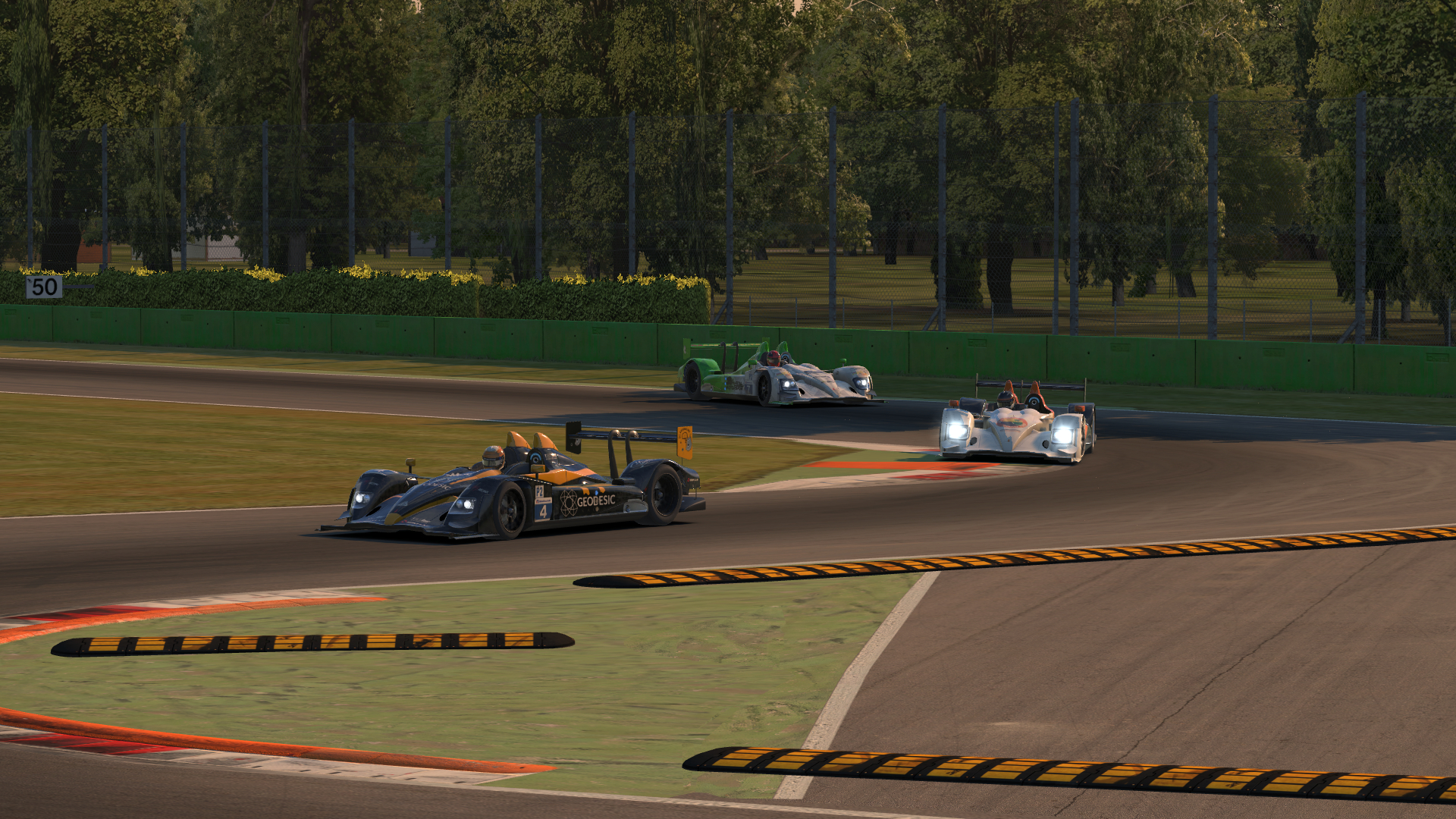
Sandwiched among the HPD leaders through the first chicane.
That plan was a success, and in the early laps, the top three of us broke away from the rest of the field. It seemed that we were all roughly the same speed, so passes would have to be made from luck in traffic, better pit strategy, or making fewer mistakes.
Traffic didn’t work in my favor, at least in our first encounter with the GT field. I lost more than a second to the HPD leader, and I actually felt a slight bit of understanding for the driver that ran into Karl early in our NEO race here. When you’re stuck in a close battle, losing even a small amount of time sitting behind a GT car through a corner seems like the end of the world.
However, I gained most of that time back with some help from LMP1 traffic and my own pace, which remained strong as the race went on. While Dean told me that the HPD is generally quite easy on its tires, in this race with clear skies and a hot track, the tires were actually showing some signs of wear. I couldn’t take some corners as aggressively as I had earlier in the race, so I moved back my braking points and modulated my throttle application — both definite GT driving characteristics that, surprisingly, were translating to a prototype.
The leader seemed to be struggling with that wear a bit more than me, and about halfway through the race, he made a mistake. Just like my closest opponent in the first race had done, he overdrove the Ascari chicane and ran through the gravel trap. As he rejoined the track, he drove across the raised kerbs, which he confirmed after the race had damaged the floor of his car and was costing him nearly a second per lap.
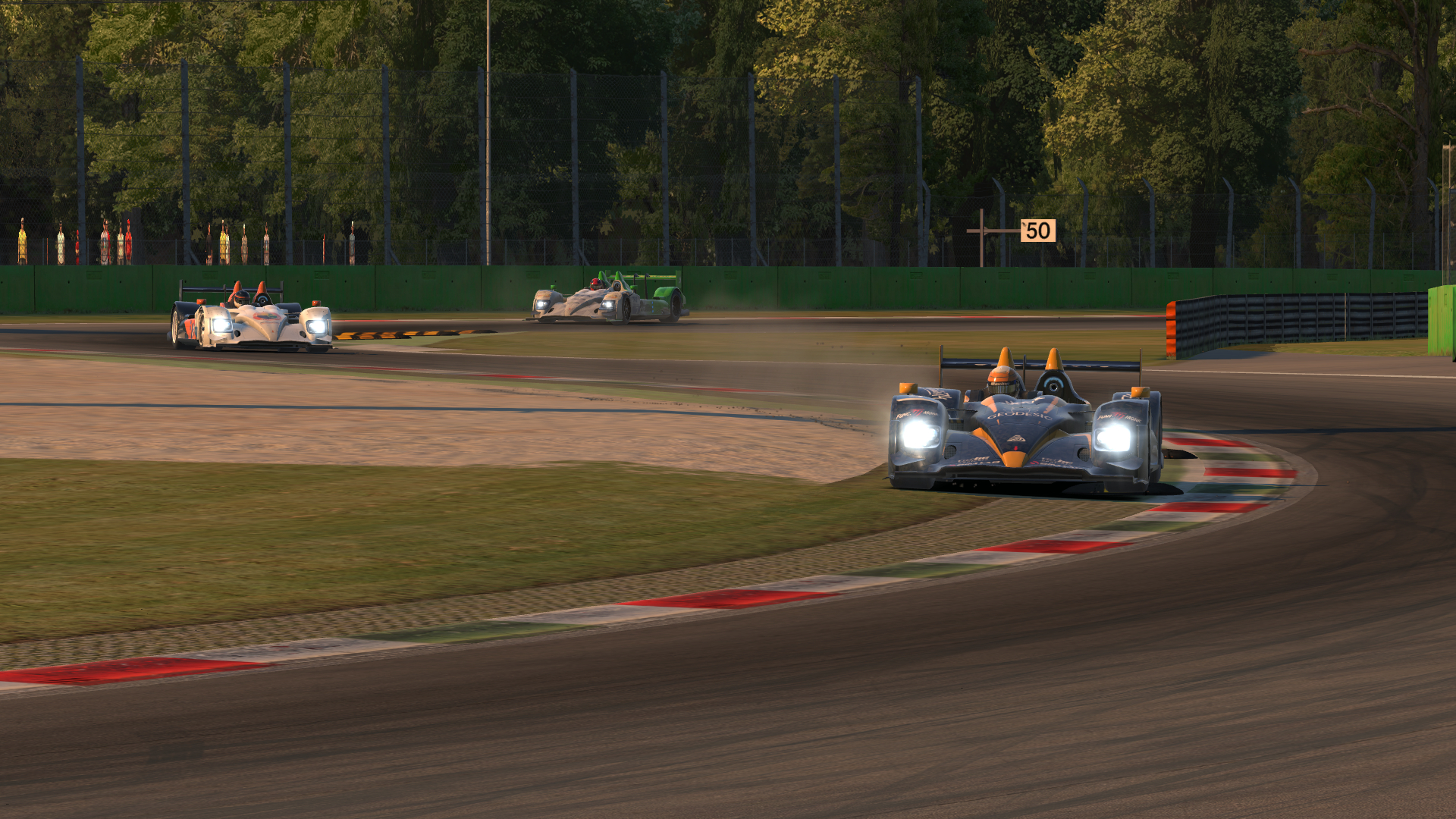
The leader cuts the course and rides the kerbs through Ascari.
After catching up to him, I hit pit road to make my stop, leaving him to navigate through some GT cars the following lap. His time lost from the damage and that extra lap in traffic cost him the lead, and after our stops, I was two seconds ahead and pulling away.
With five laps to go, I had a five-second lead over the new second-place car, who originally started in fifth but had moved forward using a consistent pace, good traffic management, and few mistakes. While I had equal or better pace than him on a clear track, even a few bad laps in traffic could have cost me my entire lead, so I couldn’t back off like I had in my first race of the week.
I still lost a couple of seconds stuck behind slower cars, including an awkward encounter with a laps-down HPD through Ascari. But just as it had earlier in the race, luck in traffic seemed to even out for everyone, and I crossed the finish line with my second win of the week in hand.
iRacing Le Mans Series - Race 2
Thursday, July 26 at 5:00 pm EDT • Strength of Field: 2401| Finish | Start | Interval | Fastest Lap | Incidents | Points | iRating | Safety Rating |
|---|---|---|---|---|---|---|---|
| 1 | 2 | Winner | 1:38.266 | 1 | 137 | 5108 (+36) | A 4.92 (+0.16) |
Series Status
In my second race, competition between classes seemed less problematic. Perhaps that was due to it being the top split with better drivers, or maybe it was from the smaller field of only 31 cars and 12 GTEs.
In the forums last season, some series drivers successfully campaigned to get the maximum field size reduced from 60 to 45 cars. Based on my experiences this week and seeing the high level of GT interest in this series, it may be worth considering another small decrease in the maximum number of cars per split.
Despite a handful of aggressive LMP1 drivers and some occasional friction in traffic, the iLMS has quickly established itself as the cream of the crop among iRacing’s multi-class series. The last time I drove in IMSA, the talent level among the DP and GTE drivers had clearly decreased and there was a worrying overlap in pace between all three classes.
Most of the good drivers from that series seem to have migrated to iLMS, and while even this series may have some drivers who are in over their heads, I suspect that many of them likely got weeded out early in the season or at least early in each race.
The three car classes play together reasonably well, although some LMP1s can be a bit slower than HPDs into corners. “We’re not as nimble as you’d expect,” noted an LMP1 driver in one of my races.
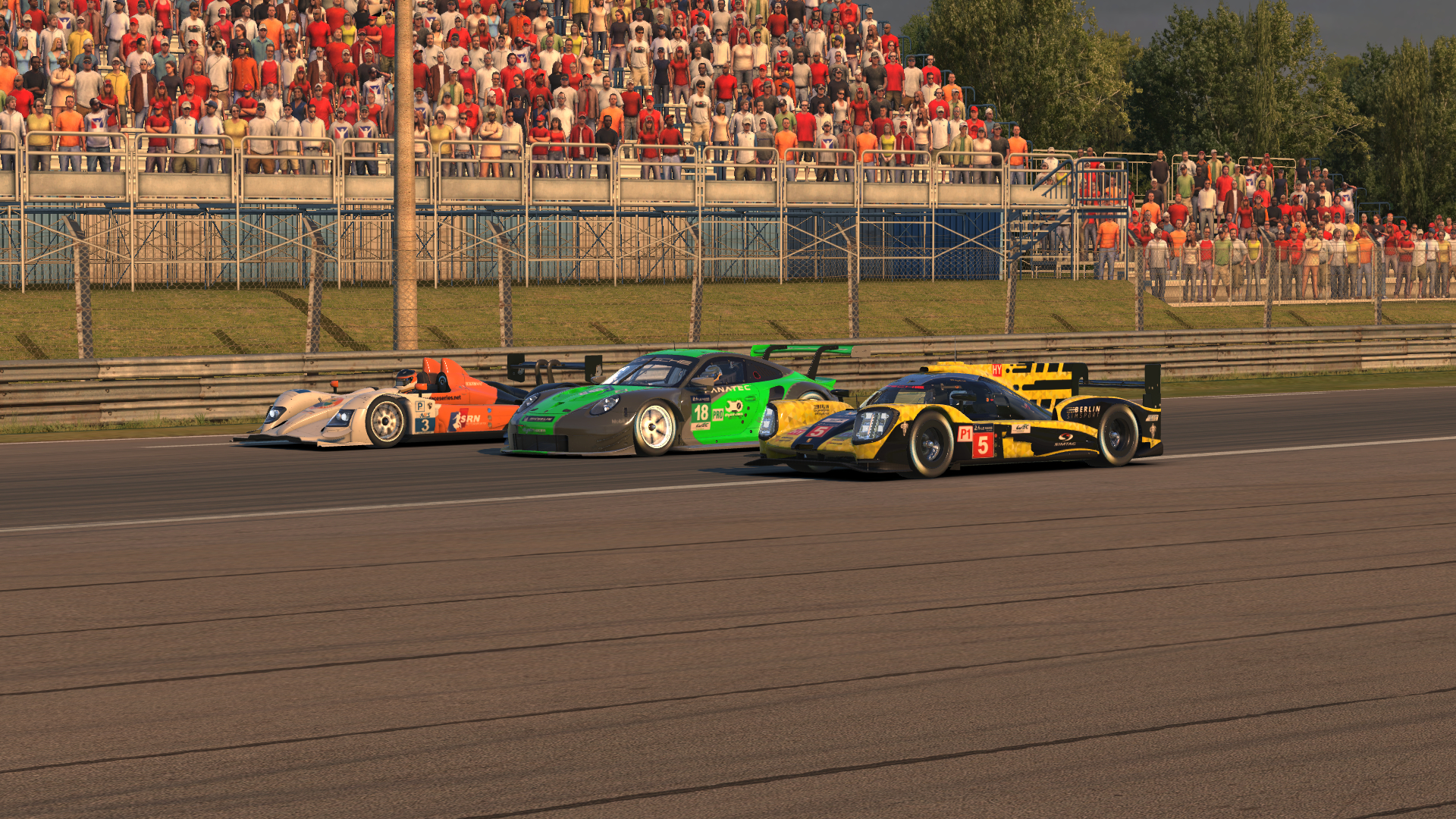
Three-wide with a pair of Porsches — one GTE and one LMP1.
The question is, can this series stay that way? A core group of LMP1 drivers has survived through the first season and a half of those cars’ tenure on iRacing, and the GTE cars are more popular than ever with the recent addition of the Porsche 911.
But what about the future of the HPD? Although it has been a mainstay on iRacing for almost seven years now, it clearly won’t last forever. iRacing’s version of the HPD is now two generations behind the current LMP2 and DPi cars, and it’s just as outdated as the old Ford GT2, which now has almost no participation.
While the HPD does still manage some strong fields each week, it also attracts only one or two drivers in many time slots, and the statistics show that the HPD-only LMP2 class is the least popular in iLMS.
Adding a modern LMP2 car would likely rejuvenate that middle class and attract the sort of prototype drivers who don’t want to deal with the advanced setups or in-race hybrid system management of the LMP1s.
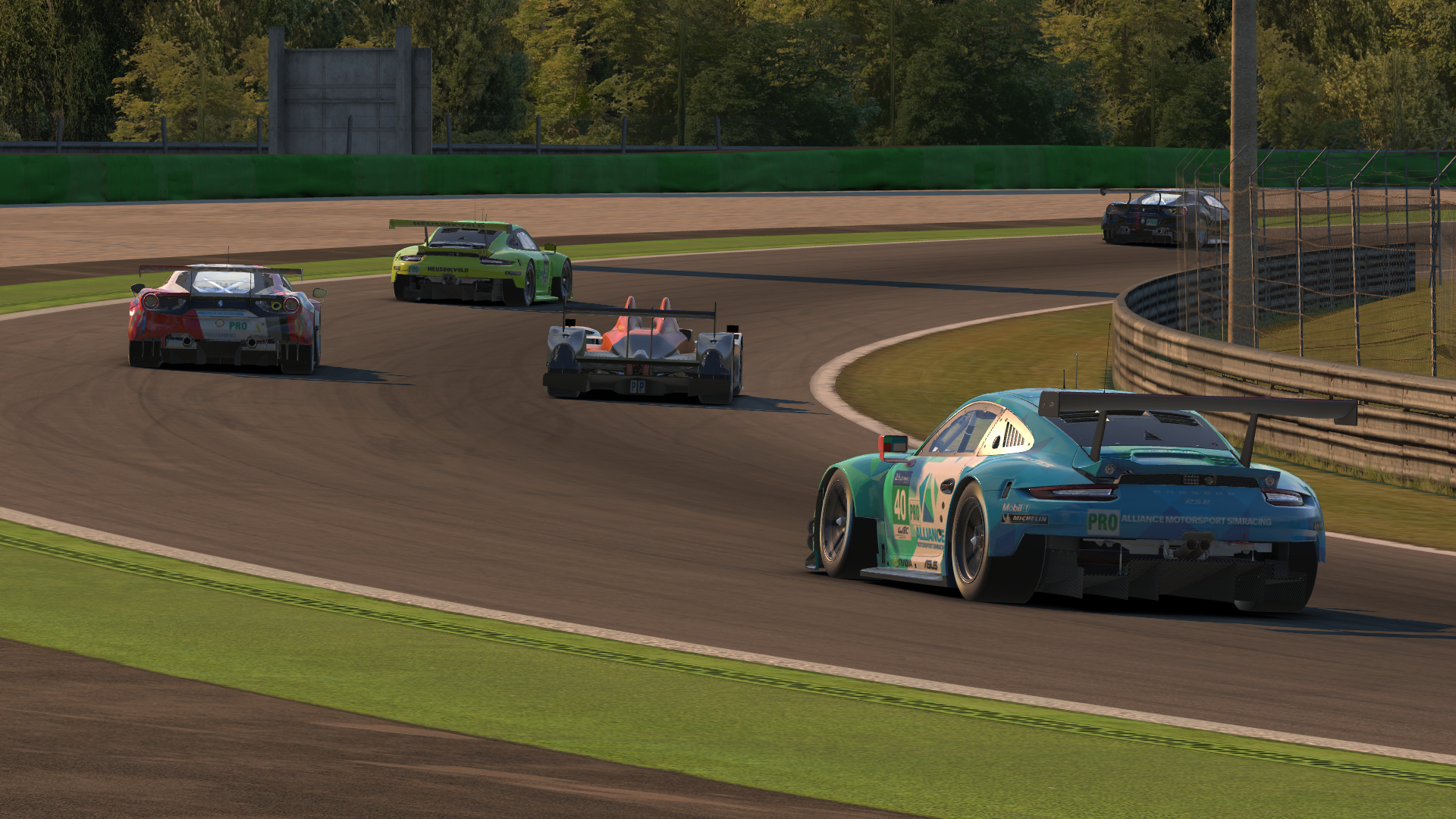
Carving through GT traffic in the Parabolica curve.
But with no hints from iRacing that such a car is on the way — and even some uncertainty on the global motorsports stage about how the LMP platform may look in a few years — the HPD may be here for a while longer.
If its days as part of competitive iRacing are numbered, I’m at least glad that I got to try it once again and make it through a pair of races without hitting anything, especially a past or present teammate.
I did feel a bit out of my element behind the wheel, with an open view of the world instead of a closed cockpit, heaps of downforce even with a low-downforce setup, and approaching traffic from a different angle than I’m used to.
If given a choice between a week of warfully wrestling the V8 Supercar or precisely piloting the HPD, I’d probably choose the V8 nine out of ten times. However, I can now appreciate the skill required to drive a prototype in an endurance race. It combines the finesse and focus required for a grand prix race and adds in moving chicanes to maneuver around.
So no, it may not be the car for me, and I may always be a GT driver at heart. But at least until the next divebomb, punt, or encounter with The Indecisive Prototype Driver that sours me about it, the HPD and a pair of victories this week taste pretty sweet.